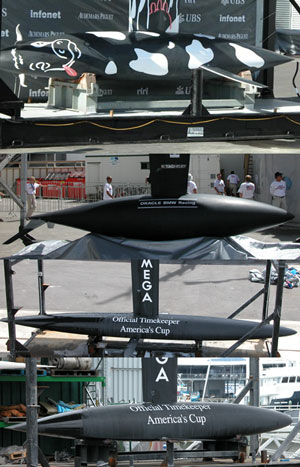
The question of whether the best was saved for last at unveiling day for the 2003 Louis Vuitton Cup finals will be answered in late February. But there’s no question that the most interesting boats brought up the tail end of the program as, just after noon, Team New Zealand lifted their two boats out of the water and debuted the much-hyped Kiwi Clip-On for the public. Though the black boats won’t start an official race for another five weeks, the rules of this Cup dictate that Team New Zealand unveil its boats with Oracle BMW Racing and Alinghi, the two remaining challengers. TNZ must now observe a no-change period from until the end of the Louis Vuitton final. Between that final race and the first race of the America’s Cup, TNZ can make changes. But there is no doubt that they will be racing with this second-skin appendage; both boats have one, and TNZ designers confirmed that the appendages are integral parts of their design.
“Weve tested this idea and found it to be faster,” said designer Mike Drummond. American Clay Oliver, who along with Tom Schnackenberg and Drummond headed up the design team that created the clip-on, said that the team committed to this approach before starting the construction of the first boat. “Its not a matter of adding something to what youve already envisioned,” said Oliver, “its a matter of thinking about a boat and how you can get that shape.”
|
|
| |
|

|
| |
| Stuart Streuli|
| |
|
|
| |
| From the top: Alinghi (the horns and cow painting will not stay on for racing, forward is to the left), Oracle, NZL-82, NZL 81. The final three are bow to the right.* * *|
| |
|
|
|
Though the Clip-On dominated the scene today, there was plenty other things to look at with Team New Zealand and two boats unveiled by Alinghi and Oracle/BMW Racing–both of which are now committed to the boats theyve sailed throughout the Louis Vuitton Cup, SUI-64 and USA-71, respectively. Among the most striking differences in the four designs–aside from the clip-on–was the winglet placement. Alinghis wings were placed just aft of the keel strut and angled slightly downward while Oracle went with aft-swept wings placed at the stern end of the bulb. Team New Zealands wings were completely level and placed mid-bulb, length-wise, but right along the bottom. There were also four different bulbs, TNZ going with an extremely long and thin bulb on NZL-82 and a much shorter, fatter bulb on NZL-81. Oracles bulb was probably the fattest and shortest, with tapered ends. Alinghis was tapered like Oracles, but more rounded on the forward end and visibly longer. There was also an interesting dimple on the Oracle bulb where the keel strut attached. Principle Oracle designer Bruce Farr called it a “dillet.” “The fin comes down with a lot of volume,” said Farr, “so you try to compensate for that.”
All of the designers did agree on one thing today, that the fastest boats are the ones on which the details have been sweated most tirelessly. Many people, said Alinghi design coordinator Grant Simmer, “underestimate a little bit what you can do in the details.” Oliver concurred saying that, with the exception of the clip-on, the improvements in the two new TNZ boats were due to, “a lot of little things, and maybe thats what makes up a fast boat.”
A few other notes from unveiling day:
1. The Team New Zealand code word for the second skin was “Hula.” To honor that the design team wore khaki and yellow Hawaiian shirts at the unveiling. Hopefully the innovation will be faster than the shirts were attractive.
2. Larry Ellison was not visible at the unveiling of Oracles two boats. Ernesto Bertarelli, however, made it over to check out his competition for the Louis Vuitton Cup.
3. One interesting above-water innovation for Team New Zealand is their use of double stays on the shrouds. Rather than one thick rod they are running two smaller rods, set one behind the other, to reduce windage.
4. Having pioneered the three-spreader Millennium Rig in 2000, Team New Zealand is now using a four-spreader version of the Millennium Rig this time around. Both Oracle and Alinghi have three-spreader rigs.
5. Simmer said that he thought SUI-64 was now 1.5 minutes faster around a theoretical course than NZL-60, which won the Cup in 2000, and that 20 to 30 seconds of that gain has come since Oct. 1.
6. TNZ was not the team that sent a request for interpretation to the rules committee in September on the legality of a second-skin appendage. Alinghi also denied being the one to send the request.
7. Alinghi served the best croissants.









